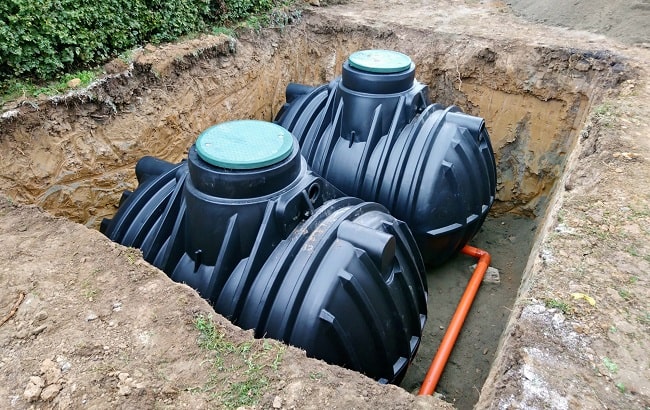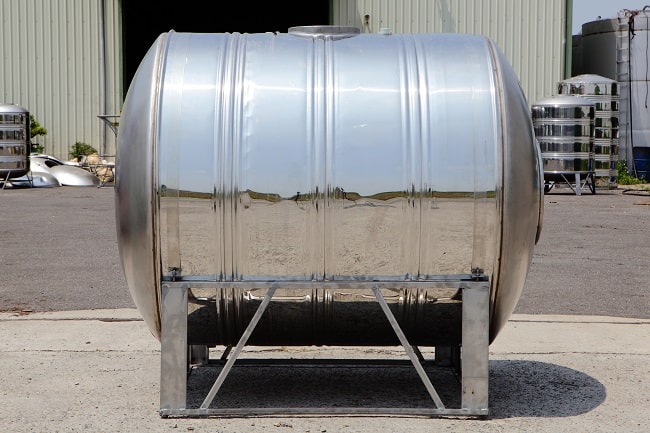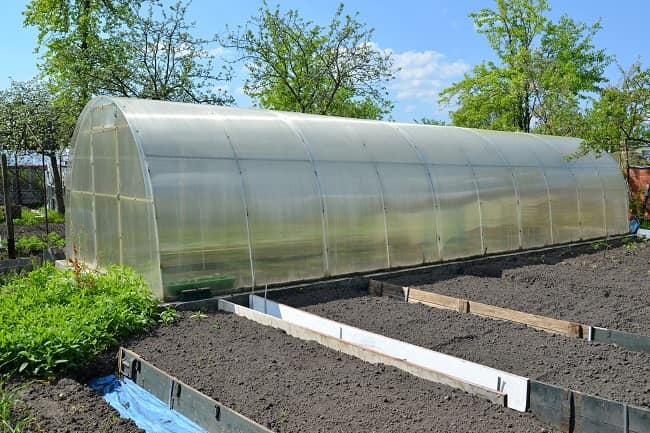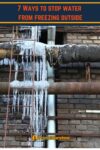In a disaster, your household water supply may run out or become contaminated, making drinking unsafe.
The CDC recommends storing “at least 1 gallon of water per person per day for three days for drinking and sanitation.”
If you can store your emergency water inside, this is ideal as it will protect it against environmental factors, especially during winter.
If you have to store your water outside, you must prevent it from freezing. Frozen water is potentially dangerous, and melting it down requires large amounts of energy, which may not be available in an emergency.
7 Ways to Stop Water from Freezing Outside
#1 Bury your Emergency Water Underground

You can prevent your water from freezing if you create an underground water storage facility below the frost line. The ground will insulate the water, helping it stay above freezing point.
Before you start digging, ensure you’re aware of the frost depth in your area. In California, for instance, you may only have to bury your water tank 5” below the surface, while in North Dakota, it will be closer to 75”. You can use this map to understand your area’s frost depth.
The bigger the tank, the better, as a larger volume of water takes longer to freeze.
Not only will this approach stop your water from freezing, but it also protects it against potential theft. The only trouble is it is more difficult to extract in an emergency than if you stored the water in an above-ground facility.
#2 Use a Steel Tank

Unlike a plastic tank, a steel tank can absorb heat from the sun and retain it long enough to keep your water warm enough that it doesn’t freeze overnight. Use the following tips to maximize your steel tank’s ability to keep your water from freezing:
- Place your tank in a location where it gets the most sunlight. For those in the northern hemisphere, southern exposure is best.
- Paint your tank black to increase its ability to absorb the sun’s heat
- Insulate your tank by wrapping it in newspapers or cheap emergency blankets
- If possible, position your tank so that it’s touching one side of your house so it can absorb some of the heat from your home.
#3 Store your Emergency Water in a Greenhouse

Even in mid-winter, the temperature inside your greenhouse will be higher than the ambient outdoor temperature.
You can increase the temperature inside your greenhouse by establishing a compost heap or open-top bin inside. Ideally, your compost pile should be quite large, measuring between 3ft2 and 5ft2. A heap of this size can reach temperatures of up to 150°F to175°F for a short time, even in winter.
#4 Insulate your Container with an Old Tire
Livestock owners have been using this trick for years, but it only works on smaller containers due to the size of the tires. A standard car tire, for instance, is designed to fit a 15-inch wheel, so it will only protect a container of the same size. You could use tractor tires to insulate larger containers that measure up to 42” in diameter.
Place the tire wherever you plan on storing your emergency water and fill it with rocks, then wedge your container into the tire. During the day, the tire will absorb heat from sunlight and transfer it to the rocks. These will then retain that heat, warming the water overnight.
A more sophisticated version of this method involves securing two tires together with bolts and then filling them with foam insulation.
#5 Insulate your Tank
Wrapping your tank in blankets or newspapers can help insulate the water and stop it from freezing. You could even use old mylar blankets, bearing in mind that these expire after a couple of years.
#6 Store your Emergency Water in a Cooler
If you are only planning on storing the quantity of water recommended by the CDC, you can keep it from freezing by storing it in a cooler.
A standard-sized cooler can hold around 20 liters of water, which will keep a family of four hydrated for five days. If you need more capacity, you can use a giant cooler to store up to 378 liters.
Just as a cooler keeps your drinks cold in summer, it will insulate water against the frigid winter temperatures.
#7 Use Water Additives
You can add various additives to water to prevent it from freezing, but it might make it taste a bit weird. Alcohol can reduce the freezing point of water by several degrees, although how effective depends on how much you use.
You don’t want your emergency water to be too alcoholic, especially when it’s cold outside. Alcohol causes the capillaries under the surface of your skin to expand, lowering your core temperature and putting you at risk of hypothermia.
If you wanted to stop a 20-liter container of water from freezing, you’d need to add 2 liters of pure alcohol. This would reduce the freezing point from 32℉ to 26.6℉, but it would also make your water quite potent!
A better idea would be to add salt, although this won’t taste very nice and will increase your level of dehydration. The recommended ratio of salt to water is 1:3.
Although some preppers suggest adding sugar, this will do little to prevent your water from freezing – it will just make it sweeter!
Conclusion
The best way to prevent outside water from freezing is to store it underground, beneath the frost line. If that isn’t an option, then using an insulated steel tank or storing it in your greenhouse are the next best solutions.




I have solar panels with batteries. I added a 12 VDC bubbler that is doing the job of controlling the freezing in my 55 gallon water barrel (we have two of these systems). 1 pump draws 1.5 A. A simple timer to give the pump a break several times throughout the day.
If camping out, sleep with it using a double bag system. This is also important for water filters.
Double bag means, a mummy bag inside a larger rectangular bag.
Works with canned food too!
If away from your sub zero camp, then leaving the cans, water, and water filters, in your bedding will work. Use the inside (sleeping personal) layer area for this.
I’m an avid camper/backpacker. I’m always hesitant to suggest leaving water bottles in the sleeping bag (such as putting a bottle of hot water in the sleeping bag before you fall asleep): If the bottle leaks, you’ve just gotten your sleeping bag wet — and that’s what you need to stay alive. Better to be safe than sorry!